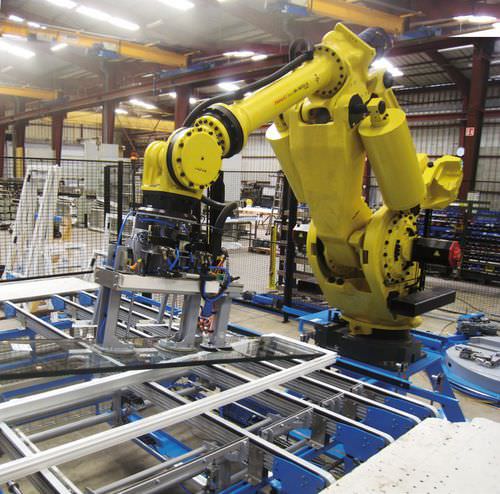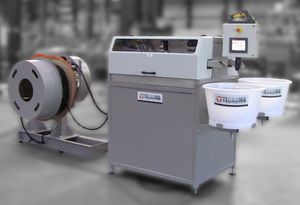
- Products
- Catalogs
- News & Trends
- Exhibitions
Robotic handling cell mountingfor glazing

Add to favorites
Compare this product
Characteristics
- Function
- handling, mounting
- Applications
- for glazing
Description
The robotised glazing cell on opening sash TECAUMA takes automatically glasses from trolleys or racks and then, unloads them in the associated sash. Therefore, the glass trolleys to deal with are flanged on a ground turntable. A poly-articulated robot, equipped with a vacuum gripper, unloads glasses, one by one, following the palletizing plan. From the other side of the cell, the opening sashes are transported on a conveyor line, following the glass loading plan (glasses are mastered on the sashes). When the sash arrives at the glazing step, it is automatically flanged and the 6 axes Robot unloads the glass on the sash. As soon as the glass has been unloaded, the sash is evacuated on the conveying line, outside the cell, to be blocked and fitted in glazing-bead on a manual workplace. The cycles will be repeated in this way. As an alternative, glasses can be supplied on a horizontal or vertical conveyor, the glazing process remain the same.
TECHNICAL FEATURES
• For single opening sashes or with a crossbar in PVC, Alu or Wood
• Horizontal or vertical glazing process, following the customer process
• Glasses palletized on trolleys or racks, the palletization plan is communicated to the cell by a barcode reader
• Or glasses delivered one by one on horizontal or vertical conveyor
• Management of integrated glass trolleys (full and empty)
• Production rate: up to 120 glazed sashes/hour
• Ergonomic and intuitive supervision software developed by TECAUMA
• Dimensional limits of the openings
• Height: from 350mm to 2800mm
• Width: from 350mm to 1500mm
• Maximum weight glazing: 150kg
Catalogs
No catalogs are available for this product.
See all of TECAUMA‘s catalogsRelated Searches
- Robotic cell
- Robotic handling cell
- Compact robotic cell
- Robotic loading cell
- Robotic machine tool cell
- Robotic machining cell
- Robotic unloading cell
- Robotic assembly cell
- Robotic cell for the automotive industry
- High-flexibility robotic cell
- Robotic palletizing cell
- Robotic cutting cell
- Gripping robotic cell
- Robotic cell for the aeronautical industry
- Robotic bending cell
- Robotic cell for medical applications
- Robotic plasma cutting cell
- Press brake robotic cell
- Robotic mounting cell
- Two-component robotic cell
*Prices are pre-tax. They exclude delivery charges and customs duties and do not include additional charges for installation or activation options. Prices are indicative only and may vary by country, with changes to the cost of raw materials and exchange rates.










